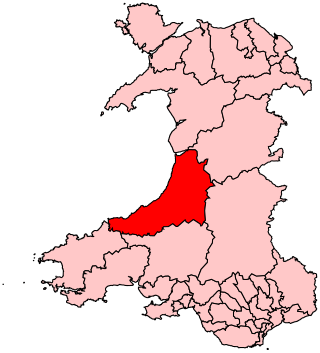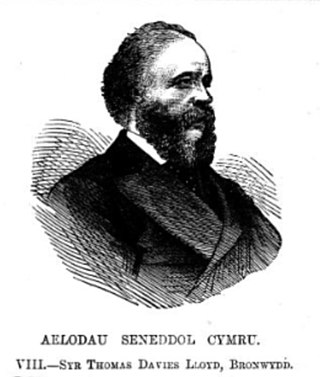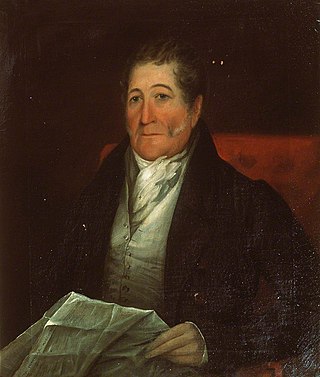Related Research Articles

Ceredigion was a parliamentary constituency represented in the House of Commons of the UK Parliament. Created in 1536, the franchise expanded in the late 19th century and on the enfranchisement of women. Its boundaries remained virtually unchanged until 1983. From 1536 until 1885 the area had two seats : a county constituency (Cardiganshire) comprising the rural areas, the other the borough constituency known as the Cardigan District of Boroughs comprising a few separate towns; in 1885 the latter was abolished, its towns and electors incorporated into the former, reduced to one MP. The towns which comprised the Boroughs varied slightly over this long period, but primarily consisted of Cardigan, Aberystwyth, Lampeter and Adpar, the latter now a suburb of Newcastle Emlyn across the Teifi, in Carmarthenshire.

Sir Thomas Davies Lloyd, 1st Baronet was a British Liberal Member of Parliament, for Cardiganshire (Ceredigion) 1865–1868 and Cardigan Boroughs 1868–1874. Although he coveted a peerage and spent a fortune in pursuit of that aim, he had to be content with a baronetcy.
The Cardigan District of Boroughs was a parliamentary constituency in Wales which returned one Member of Parliament (MP) to the House of Commons of the Parliament of the United Kingdom and its predecessors, from 1542 until it was abolished for the 1885 general election. The borough constituency comprised the four towns of Cardigan, Aberystwyth, Lampeter and Adpar - geographically separated from each other but all within the county of Cardiganshire.
The office of High Sheriff of Cardiganshire was established in 1541, since when a high sheriff was appointed annually until 1974 when the office was transformed into that of High Sheriff of Dyfed as part of the creation of Dyfed from the amalgamation of Cardiganshire, Carmarthenshire and Pembrokeshire. Between the Edwardian Conquest of Wales in 1282 and the establishment of the High Sheriff of Cardiganshire, the sheriff's duties were mainly the responsibility of the coroner and the Custos Rotulorum of Cardiganshire. The office of High Sheriff remained first in precedence in the county until the reign of Edward VII when an Order in Council in 1908 gave the Lord Lieutenant of Cardiganshire the prime office under the Crown as the sovereign's personal representative.

Clan Campbell of Cawdor is a highland Scottish clan and a branch of the larger Clan Campbell. While the clan is recognised by the Standing Council of Scottish Chiefs, the clan does not have a clan chief recognised by the Standing Council of Scottish Chiefs. Also, because the clan does not have a clan chief recognised by the Lord Lyon King of Arms it is considered an armigerous clan. The head of the Clan Campbell of Cawdor is the Earl Cawdor, currently held by Colin Campbell.
John Campbell of Stackpole Court and Cawdor (1695–1777), was a British politician. He was a Member of Parliament (MP) for Pembrokeshire, Nairnshire, Inverness Burghs and Corfe Castle.

Sir Richard Pryse, 2nd Baronet was a Welsh landowner and politician who sat in the House of Commons in 1660.
Sir Richard Pryse, 1st Baronet was a Welsh politician who sat in the House of Commons from 1646 to 1648.
James Lewis was a Welsh politician who sat in the House of Commons at various times between 1624 and 1656. He supported the Royalist and then the Parliamentary side in the English Civil War.

There have been two baronetcies created for members of the Pryse family, one in the Baronetage of England and one in the Baronetage of the United Kingdom. Both creations are extinct.
Sir Richard Pryse was a Welsh politician who sat in the House of Commons from 1584.
Rowland Pugh was a Welsh politician who sat in the House of Commons from 1624 to 1625.

Pryse Loveden Pryse of Gogerddan, Cardiganshire and Buscot Park, Berkshire was a British Lord Lieutenant and Member of Parliament for Cardigan Boroughs from 1818 until his death in 1849.

Colonel Edward Lewis Pryse was a British Liberal politician.
Francis Cornwallis of Abermarlais, was a Welsh Tory politician who sat in the House of Commons from 1722 to 1728.
John Pugh of Mathafarn, Llanwrin, Montgomeryshire, was a British lawyer and Tory politician who sat in the English and British House of Commons from 1705 to 1727.

Richard Lloyd, of Mabws, Cardiganshire, was a Welsh Whig politician who sat in the House of Commons from 1730 to 1741.

Gogerddan, or in English, Gogarthen, was an estate near to Trefeurig and the most important in what was then the county of Cardiganshire, Wales. Owned since at least the fifteenth century by the Pryse family, the main house, called Plas Gogerddan, still stands and is a Grade II listed building. The estate became especially wealthy from the seventeenth century on the profits from lead mining, which is when the house was constructed. The house was significantly altered in the 1860s and was sold by Sir Pryse Loveden Saunders-Pryse to University College of Wales in 1949.

The flag of Ceredigion is the de facto flag of Ceredigion, Wales. The earliest source referring to the flag dates back to 1611. The flag enjoys widespread usage throughout the county.
Ceredigion Historical Society was founded in 1909.
References
This article relies largely or entirely on a single source .(May 2014) |